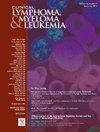新诊断多发性骨髓瘤中的 VCd 与 VRd:巴尔干骨髓瘤研究小组(BMSG)的真实世界匹配分析。
IF 2.7
4区 医学
Q2 HEMATOLOGY
引用次数: 0
摘要
背景:硼替佐米、地塞米松和环磷酰胺(VCd)因其活性和低毒性仍是一种流行的治疗方案,而硼替佐米、来那度胺和地塞米松(VRd)则在美国和欧洲被广泛使用;这两种药物都与抗CD38单克隆抗体联合使用,但VCd和VRd尚未在有充分支持的前瞻性试验中进行直接比较。目的:我们比较了真实世界中接受VCd(690人)或VRd(526人)治疗的1216名患者的疗效:结果:接受 VCd 治疗的患者多伴有严重肾功能不全、ISS-3 疾病、高钙血症、LDH 升高、贫血、血小板减少、表现不佳,而接受 VRd 治疗的患者年龄较大,接受自体移植的次数较少,但接受维持治疗的次数较多,但诱导治疗的持续时间相似。在单变量分析中,VRd与更高的诱导总反应率和CR/VGPR率(P < .001)以及更佳的PFS和OS相关,尤其是在标准风险疾病、无肾功能障碍和老年人中;然而,在多变量分析中,PFS和OS均无显著差异。在主要预后变量1:1严格匹配的患者中(每组188人,共376人),VRd在应答率和应答深度方面的优势得到了证实,但在PFS或OS方面没有显著差异:结论:与VCd相比,VRd是一种更积极的诱导方案,但使用来那度胺维持治疗可能会削弱PFS或OS的益处。在特殊情况下,VCd 诱导仍是一种选择。随着单克隆抗体的应用,对于无法使用或不能耐受VRd的患者,可以考虑以VCd为骨干。本文章由计算机程序翻译,如有差异,请以英文原文为准。
VCd versus VRd in Newly Diagnosed Multiple Myeloma: Matched Real-World Analysis from the Balkan Myeloma Study Group (BMSG)
Background
Bortezomib, dexamethasone and cyclophosphamide (VCd) remains a popular regimen, due to its activity and low toxicity, while bortezomib, lenalidomide and dexamethasone (VRd) is widely used in US and Europe; both are combined with anti-CD38 monoclonal antibodies but VCd and VRd have not been compared directly in adequately powered prospective trials.
Aim
We compared the outcomes of 1216 patients treated with VCd (N = 690) or VRd (N = 526) in a real-world setting.
Results
Patients treated with VCd had more often severe renal dysfunction, ISS-3 disease, hypercalcemia, elevated LDH, anemia, thrombocytopenia, poor performance while VRd-treated were older and received less often autologous transplant but more frequently maintenance but the duration of induction was similar. VRd was associated with substantially higher overall response and CR/VGPR rates to induction(P < .001) and improved PFS and OS in univariate analysis, especially among patients with standard risk disease, without renal dysfunction and in the elderly; however, in multivariate analysis there was no significant difference in either PFS or OS. In patients strictly matched 1:1 for major prognostic variables (188 in each group, total N = 376), the superiority of VRd in terms of responses rates and depth of response was confirmed, but without significant PFS or OS difference.
Conclusion
VRd is a more active induction regimen than VCd, although use of maintenance with lenalidomide may dilute the PFS or OS benefit. VCd induction remains an option in special circumstances. With the implementation of monoclonal antibodies, VCd backbone can be considered for patients without access to or who do not tolerate VRd.
求助全文
通过发布文献求助,成功后即可免费获取论文全文。
去求助
来源期刊

Clinical Lymphoma, Myeloma & Leukemia
ONCOLOGY-HEMATOLOGY
CiteScore
2.70
自引率
3.70%
发文量
1606
审稿时长
26 days
期刊介绍:
Clinical Lymphoma, Myeloma & Leukemia is a peer-reviewed monthly journal that publishes original articles describing various aspects of clinical and translational research of lymphoma, myeloma and leukemia. Clinical Lymphoma, Myeloma & Leukemia is devoted to articles on detection, diagnosis, prevention, and treatment of lymphoma, myeloma, leukemia and related disorders including macroglobulinemia, amyloidosis, and plasma-cell dyscrasias. The main emphasis is on recent scientific developments in all areas related to lymphoma, myeloma and leukemia. Specific areas of interest include clinical research and mechanistic approaches; drug sensitivity and resistance; gene and antisense therapy; pathology, markers, and prognostic indicators; chemoprevention strategies; multimodality therapy; and integration of various approaches.
 求助内容:
求助内容: 应助结果提醒方式:
应助结果提醒方式:


